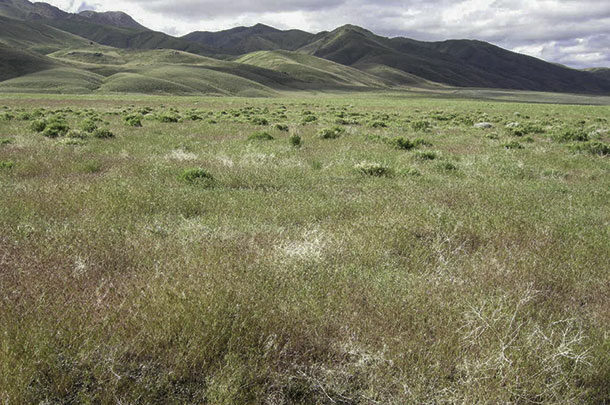Strategic grazing on cheatgrass-dominated rangelands can control this invasive annual grass and reduce wildfires. Barry Perryman, rangeland ecology and management, University of Nevada, says cheatgrass (downy brome) was introduced to North America years ago but, in the recent decades, greatly increased across the West. “This grass is native to central Asia, but they don’t have issues with it and don’t have range fires. If any forage is available, something eats it,” he says.
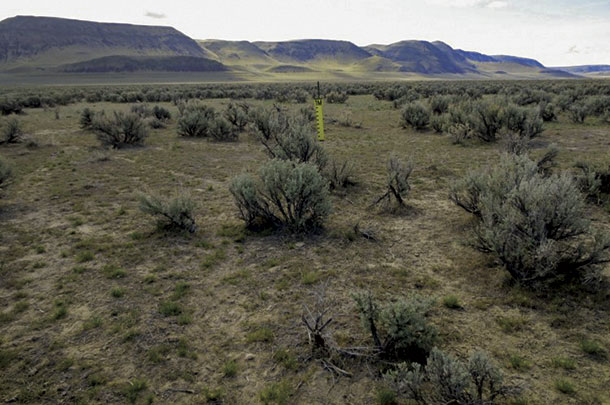
The contrast between cheatgrass heavily grazed in winter on private land (cleaned up). Photo provided by Barry Perryman.
“Here in the U.S., ever since the late 1970s, we thought we needed to leave more grass; environmental groups pressured federal agencies to cut back on AUMs. We’ve allowed carryover fuels to accumulate, resulting in catastrophic fires,” says Perryman.
He started an experimental project, grazing cheatgrass in the fall. Many Nevada ranchers utilize cheatgrass in the spring when it’s nutritious and palatable, but by the time it goes to seed, protein level drops and livestock avoid the sharp seed awns. “They won’t eat it if there’s anything else to eat. Yet, later in the year after seeds drop, the plant is palatable again. If we can get animals to eat it in the fall, this alleviates some of the logistical challenges of trying to graze it in the spring,” he says.
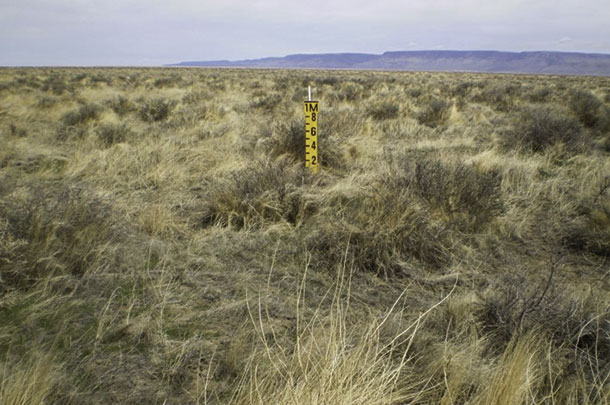
Cheatgrass on BLM that was not grazed. Photo provided by Barry Perryman.
“If it’s a warm, wet early spring, cheatgrass is green and growing in February in Nevada. On a cold dry spring, it may not start growing until April. You don’t know when there will be enough early grass to turn cattle out, so it’s difficult to plan – not knowing how many animals it will take to reduce cheatgrass for fuels management,” says Perryman.
“If you wait until seeds drop in July or August, you can determine pounds per acre and how many animals are needed to graze it down to target level for fuels management. You can plan for when to turn cattle out and how long it will take to graze that amount of cheatgrass,” he explains.
If there’s 500 pounds of old dry cheatgrass per acre on Sept. 1, and you can reduce that to 200 pounds per acre, this may be the difference between being able to control a fire. “Even if we get fall rain and don’t have to worry about fire that fall, this would be 300 pounds per acre we won’t carry over into next year,” he says.
People earlier thought cattle won’t eat dry cheatgrass because of low nutritional quality. “We found energy level pretty high [structural carbohydrates that cattle convert to energy during rumen digestion], but crude protein [CP] can be low.”
Protein supplement increases feed intake. Cows need protein to feed microbes in the rumen that digest fiber and turn into energy. If a ruminant is short on protein, digestion slows down and the animal can’t eat as much forage, and loses weight. With protein supplement, cattle consume more cheatgrass.
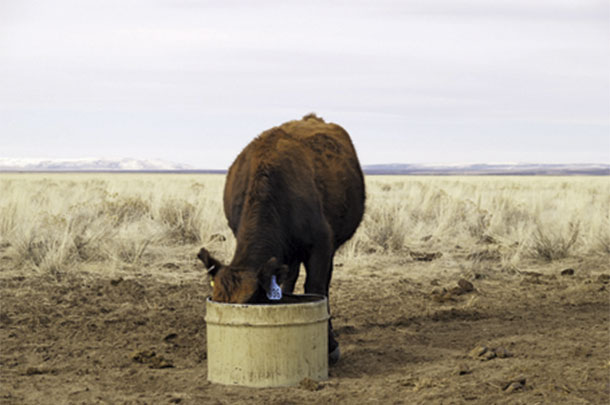
Supplement tubs are used to distribute cattle in the areas where grazing needs to take place. Photo provided by Stacey Davies/Roaring Springs Ranch.
“We put out supplement tubs, moving them around to improve cattle distribution in areas we wanted grazed. We published our initial study in the Professional Animal Scientist in March 2014,” Perryman says.
“We saw seed bank reduction in grazed areas. Even though the plants are grazed after dropping seeds, grazing makes a big difference. Cheatgrass does not establish very well on bare soil. It needs litter – old plants from previous years – to protect the seed. It germinates in that litter. If you clean up the litter [grazing in the fall], seed that’s still there may germinate but dies,” he says.
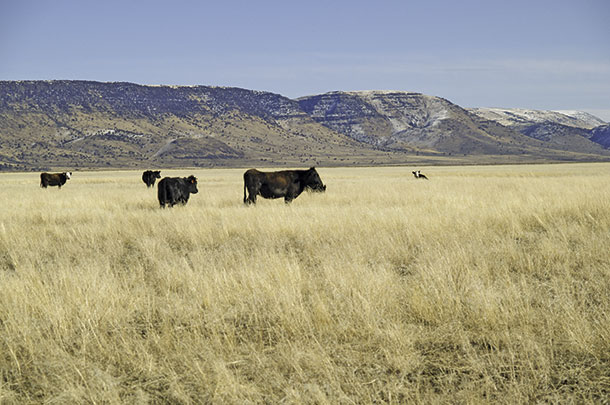
An area of the ranch being grazed in winter, with cattle starting to graze the dry grass. Photo provided by Stacey Davies/Roaring Springs Ranch.
“Fall grazing reduced seeds down to about 2,000 seeds per square meter, which made a difference in whether cheatgrass could dominate perennial grasses. If you stop fall grazing for just one year, however, the cheatgrass seed bank rebounds back up to original numbers,” says Perryman.
“If there are any perennial grasses, within about three years of fall grazing we can shift dominance from cheatgrass to perennials.” Without the thick stand of cheatgrass, young perennials have access to more sunshine, water and soil nutrients.
After three years’ grazing, there was flip-flop in numbers on the 1,500-acre study area. At first, it was about 500 pounds of cheatgrass per acre and only 100 pounds of perennial grass production. By the end of three years, it was the opposite. “We started a larger study at the TS Ranch on 6,000 acres. We had 800 cattle there for five weeks, grazing a straight line across the landscape. We concentrated the animals in that area, and results will soon be published,” says Perryman.
Roaring Springs Ranch
Several projects are ongoing in Nevada and Oregon. Stacy Davies manages Roaring Springs Ranch near French Glen, Oregon, and grazes cheatgrass late October through January, using protein supplements to encourage cattle to utilize specific areas.
“Spring grazing also works, if you monitor the grass. As soon as perennials start growing, you must get off that pasture,” Davies says. “We always tried to graze cheatgrass in spring, but now we do more winter grazing and it works better. In fall and winter, it’s easier to manage the grazing because perennials are dormant; it doesn’t hurt them. We’re seeing steady increase in perennials and decrease in cheatgrass. We’ve been doing this 10 years and now have three times as much perennial grass as when we started.”
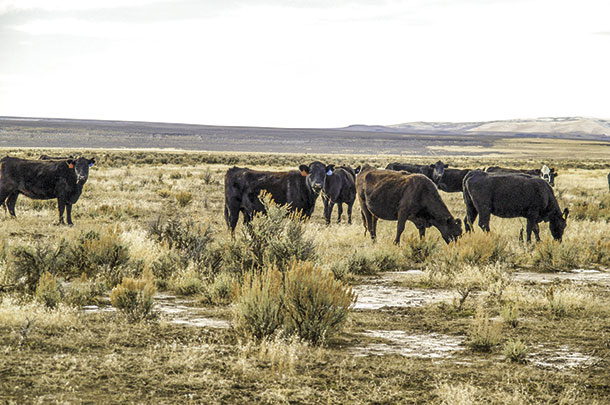
The same pasture pictured above after the cattle grazed it for a while removes all the standing dry grass. Photo provided by Stacey Davies/Roaring Springs Ranch.
It’s important for grazing management to be biologically driven. “If there’s a lot of cheatgrass in a certain area, we put in lots of cattle; if there’s only a little, we go with less numbers. Flexibility is key, for timing and numbers,” he says.
“All too often, once we get cheatgrass on a range, it burns every five or six years. But if we graze in the fall and remove that fine fuel, this reduces fire frequency, and we can control the fires that do occur.” After a bad fire, about the only thing that comes back is cheatgrass and weeds, and it’s a vicious cycle.
“On our ranch, we started spring grazing cheatgrass areas 25 years ago and have only been doing fall grazing the last 10 years. In areas that were overtaken by cheatgrass, we’ve been able to eliminate fires,” Davies says.
“In 2012, we grazed areas in the spring that were at risk of burning and brought fine fuels down to a level that we didn’t have fire. North of us, the Homestead fire burned 300,000 acres that summer – from our boundary north. East of us, the Longdraw fire burned more than a million acres. On our private land, thoroughly grazing the lower elevations to remove cheatgrass eliminated fire danger. We had lightning strikes but no fires. On both sides of us, conditions were perfect for big fires, and they burned.”
Fires are costly to government agencies and taxpayers, whereas grazing can make money and produce a beneficial product. “It’s nice to use that resource to generate revenue for the economy. Converting cheatgrass to beef makes us all money rather than costing taxpayers to fight fires,” says Davies.
